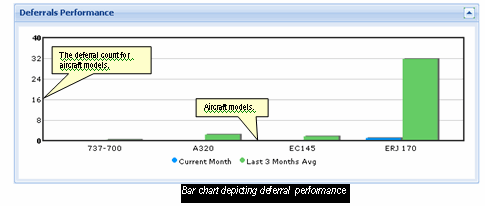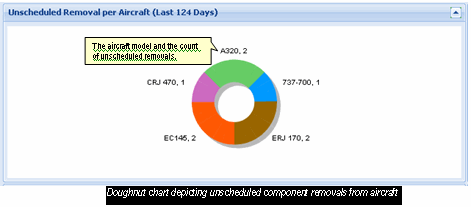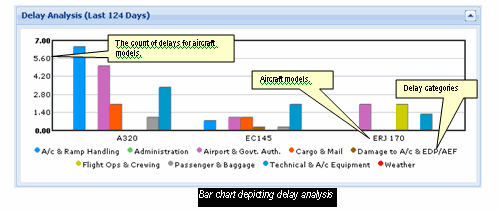Reviewing maintenance operations of aircraft fleet
This activity is essentially a report that provides maintenance heads with a snapshot of maintenance information on the entire aircraft fleet.
Select the "Maintenance Operations Dashboard" link under the “Flight Log” business component.
The “Maintenance Operations Dashboard" page appears.
Enter the following in the "Date Reference" group box:
|
Reference Date |
The date for which you want to view maintenance information for the aircraft fleet of the organization unit. This page retrieves and displays information for the period between the reference date and the current date. However, some of the sections in this page show information as available till date. |
Click the “Get Details” push button.
This page retrieves and displays information for the period between the reference date and the current date. However, some of the sections in this page show information from dates earlier than the reference date. The maintenance information on the fleet of aircraft grouped in specific categories is displayed under various sections. Following is a brief explanation of the information available in each of the sections of the page.
Fleet Status
The “Fleet Status” section shows operational details of the entire fleet of aircraft regardless of the aircraft model as on the current date. The information showed here helps to know the status of every aircraft, whether operational, grounded or no longer in use.
|
Aircraft Reg # |
The registration number of the aircraft in the fleet of the organization unit. |
|
Model # |
The model of the aircraft. |
|
Condition |
The operational state of the aircraft. |
|
Status |
The user-defined status of the aircraft. |
|
AOG ? |
Indicates the AOG status of the aircraft. |
|
Open MEL Count |
The total number of MEL discrepancies reported for the aircraft. |
|
Remaining Time |
The flying time available until the earliest maintenance event planned for the aircraft. |
|
Last Journey Log |
The registration number of the last journey log created for the aircraft. This identifies the last journey made by the flight on or before the reference date. |
Note: 1) The ![]() button indicates the AOG status of the aircraft is “No”.
button indicates the AOG status of the aircraft is “No”.
2) The ![]() button indicates the aircraft is grounded, that is the AOG status is “Yes”.
button indicates the aircraft is grounded, that is the AOG status is “Yes”.
AOG Parts
The AOG Parts section displays part requirement details of aircraft with AOG status as on the current date. The information in this section helps to determine those aircraft that remain grounded owing to non-availability of parts.
|
Aircraft Reg # |
The registration number of the aircraft in the fleet of the organization unit. |
|
Part # |
The part for which material request has been generated with MR Priority as “AOG”. |
|
Qty |
The quantity of the part available in the warehouse. |
|
Warehouse |
The warehouse that has requested for the part. |
|
Material Request # |
The material request generated for the part with AOG status. |
|
Ref. # |
The reference document for the aircraft. |
|
Planner Comments |
Information provided by the planner with regard to the acquisition of the part. |
|
Expected Receipt Date |
The receipt date of the part by the material request. |
Note: 1) The ![]() button indicates the Expected Receipt Date for material request for the grounded aircraft is available.
button indicates the Expected Receipt Date for material request for the grounded aircraft is available.
2) The ![]() button indicates the Expected Receipt Date for material request is not yet available.
button indicates the Expected Receipt Date for material request is not yet available.
Open Deferrals
The “Open Deferrals” section displays details of discrepancies in “Deferred” status for the period between the reference date and the current date. The Open Deferrals section displays details of discrepancies in “Deferred” status for the period between the reference date and the current date. You can find a break-up of deferred discrepancies on the basis of deferral type and model.
|
Model # |
The aircraft model in the aircraft fleet. |
|
Aircraft Count |
The total number of aircraft of the model. |
|
Deferral Type |
The deferral type of discrepancy. |
|
Deferral Count |
The total number of discrepancies deferred with the deferral type for all the aircraft of the model. |
Note: 1) The ![]() button indicates the count of open deferrals is less than 25.
button indicates the count of open deferrals is less than 25.
2) The ![]() button indicates the count of open deferrals is more than 25.
button indicates the count of open deferrals is more than 25.
Deferrals Performance
The “Deferrals Performance” section illustrates the count of deferred discrepancies for the current month as well as the average count of deferred discrepancies for the last three months. The following graph helps to analyze those aircraft models that contribute majorly to the deferred discrepancy count.

Unscheduled Removals per Aircraft (Last * days)
The Unscheduled Removals per Aircraft (Last * days) section depicts the aircraft model-wise count of unscheduled removals for the period between reference date and the current date with the pie chart. You can determine the unplanned component replacements in aircraft and arrive at a pattern for component troubles associated with a model as shown below.
Note: The * in the (Last * days) is the number of days for the period between the reference date and the current date

Open Escalations
The Open Escalations section shows details of escalated maintenance tasks that yet to be closed as on current date. With this information you can ascertain those aircraft that are awaiting maintenance.
|
Aircraft Reg # |
The registration number of the aircraft in the fleet of the organization unit. |
|
Task # |
The task planned for the aircraft. |
|
Due At |
The new date of execution of the task on the aircraft after escalation. |
|
Escalated by |
The days by which the task was escalated or pushed forward. |
|
Reason |
The cause for escalating the task. |
Delay Analysis (Last * days)
The Delay Analysis (Last * days) section illustrates delay category-wise delays for each of the models in the aircraft fleet. You can also find the count of delays reported under specific delay categories for the period between the reference date and the current date. The following bar chart helps you to analyze delays vis-à-vis category and model as shown here.
Note: The * in the (Last * days) is the number of days for the period between the reference date and the current date

Delay Analysis (Hours per fleet) - Last * days
The “Delay Analysis (Hours per fleet) - Last * days” section displays details of aircraft model-wise flight delays for the period between the reference date and the current date. This kind of information highlights those causes that delay specific models of aircraft at different stations.
|
Station |
The station at which the flight delay was reported. |
|
Model # |
The aircraft model in the aircraft fleet. |
|
No of Delays |
The count of flight delays reported for all aircraft of the model. |
|
Delay Hrs |
The total count of hours of flight delay reported for all aircraft of the model. |
|
Reason for Delay |
The causes for flight delays for all aircraft of the model. |
Aircraft Utilization (Last * days)
The “Aircraft Utilization (Last * days)” section displays aircraft-model-wise aircraft utilization details for the period between the reference date and the current date. You can find the average utilization of life tracking parameters including the average FH for every FC for each model of aircraft.
|
Model # |
The aircraft model in the aircraft fleet. |
|
A/C Account |
The count of “Active” aircraft of the model. |
|
Avg, FC per A/C |
The average count of FH for a FC for the model. |
|
Total Service Days |
The total count of flight days for all aircraft of the model. |
Avg. A/c Flight Hours/Flight Cycles (Last * days)
The Avg. A/c Flight Hours/Flight Cycles (Last * days) section gives a graphic picture of the data displayed in the “Aircraft Utilization (Last * days)” section. You can analyze the average FH per FC for each of the aircraft models for the period between the reference date and the current date.
Note: The * in the (Last * days) is the number of days for the period between the reference date and the current date

The following data for the aircraft fleet must be available in the system.
Operational condition and physical location of aircraft
Material requirements of aircraft with AOG status
Maintenance activities including schedule, execution and deferment of discrepancies; schedule , execution and short term escalation of tasks
Flight and journey details including delays
Average utilization of aircraft.